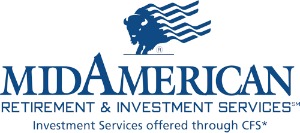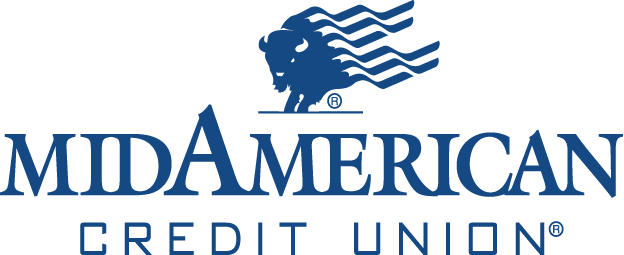
 New Loan Options for Financing Home, College
New Loan Options for Financing Home, College
If going to college or owning your home are among your life goals, Mid American Credit Union has two new loan programs to help you achieve those goals.
No money down
Being able to afford a down payment keeps many potential homebuyers from purchasing homes. According to a recent study by Bankrate, around half say that higher costs of living and not having a high enough income are major hurdles to becoming homeowners.
With increased home prices, the amount needed for the down payment that many lenders require with conventional mortgages — often 20% of the purchase price — is also rising.
To help members meet that challenge and move into their own home sooner, Mid American is offering a new no-money-down mortgage loan option; it’s called our Advantage Home Loan. With this loan, private mortgage insurance (PMI) is not required. PMI is required with a conventional loan if the down payment is less than 20%. The PMI premium is added to the homeowner’s monthly mortgage payment.
While the interest rate for an Advantage Home Loan will be slightly higher (about 0.5%) than for a conventional home loan, the benefits are zero down and no PMI. Your monthly payment with an Advantage Home Loan may likely be about the same as if you had put 20% down or needed to purchase PMI.
Advantage Home Loans will be locally underwritten, meaning potential homebuyers will work directly with one of our mortgage loan officers to determine eligibility and process the loan. Also, borrowers won’t be charged prepayment penalties for paying off all or part of the loan early.
To find out more about this loan option or to apply, visit midamerican. coop/advantage.
Student loans now offered
With the rising costs of a secondary or college education, many students may need a student loan option, which we now provide. MACU has partnered with Sallie Mae® to offer student loans for undergraduate, career training or graduate programs. The loans will be made by Sallie Mae Bank and will have competitive interest rates and multiple repayment options.
For more information, visit midamerican.coop/studentloans.
 How to do a Balance Transfer
How to do a Balance Transfer
While a balance transfer is not a magic fix, it can be an option for digging yourself out of high-interest card debt. With a balance transfer, your high-interest credit card balance (or multiple balances) is transferred to a single, lower-interest rate credit card.
Check current credit card balance(s) and interest rate(s).
Credit card interest rates show up as annual percentage rate or APR. You will want to find a balance transfer card that can accept the entire balance of what you’re trying to transfer and has a lower interest rate than what you are already paying.
Pick the right card.
Some other things to consider as you do your research: Is an introductory low APR offered and will the promotional period be long enough for you to pay off as much of your balance as possible? How long will you have to transfer your existing balance? What kind of fees will you be charged? Many transfer cards will charge a balance transfer fee, typically in the 3%-5% range of the amount transferred. Make sure it isn’t more expensive for you to make the balance transfer than it is for you to stay with the original card.
Read all the fine print and understand the terms and conditions. There are some important details to consider before you commit and move forward so you want to read all the fine print. The card issuer will likely set a credit limit for the new card; if that limit doesn’t cover the balance transfer, then that specific card might not be the right fit for you. There might also be restrictions on which cards can be transferred to your new card.
Apply for the card.
Usually, you complete an online application with all the pertinent information about your transfer(s). Sometimes applying for a balance transfer credit card results in a hard inquiry on your credit report, which can result in a temporary decline in your credit score. However, you can also see a positive impact as you boost your available credit and lower your credit utilization, which are factors in determining your credit score.
Conduct the transfer.
The easiest way to finalize the balance transfer is with a phone call to the new credit card company. It can take several days, or even weeks, for your balance(s) to fully transfer to the new card; you should continue making payments on those cards while you wait to avoid late fees on top of everything else.
Keep paying down your debt.
If you weren’t approved for the full balance transfer amount requested, you need to continue paying on the balances that didn’t transfer. To pay off debt the fastest, make payments on the balance transfer card first. It’s important to make those payments on time each month because some cards will force you out of your low introductory rate if you’re late even once. Paying off your debt when your APR is the lowest will help save you money on interest.
5 Manage Your Debit Card, Account With Free Card Manager App
With Mid American’s free Card Manager app, you have greater control over how your debit card is used with just the tap of your finger.
The user-friendly app, which can be downloaded to your smartphone from the App Store or Google Play, has tools to help prevent overspending and fraud, plus tools to track your account.
For example, you can set spending limits and where it can be used — which comes in handy if you’ve given your card to your teenager and want to control their spending. If you misplaced your card and are worried someone might find it and use it, you can prevent that from happening by turning your card off.
You can add another layer of control by setting geographical preferences for where your card can be used.
The app also lets you stay on top of your finances by giving your real-time balances and transaction details.

Be Prepared Before Disaster Hits
You can’t stop a force like Mother Nature, but there are several things you can do to be prepared for bad weather and its aftermath.
Check your insurance.
Review your homeowners or renters insurance to ensure you have coverage for the natural disasters that your area is prone to. To cover floods and earthquakes, you’ll likely need separate policies. Ensure that your policy has enough replacement cost coverage to rebuild your home and replace items lost or destroyed. Make a home inventory list and keep hard copies in a disaster kit or safe deposit box. Remember, if you store the list digitally that you will need power and network access to pull up that list.
Make a sheltering/emergency plan.
The safest place to shelter in your home during a tornado is the interior part of a basement or an inside room without windows on the lowest floor (such as a hallway, closet or bathroom). If you live in a multi-family area, such as an apartment complex or mobile home park, know where your community shelter is.
Create a disaster kit.
While disaster teams tend to respond quickly, experts recommend that you have three days worth of items to see you through. Pack a large watertight container with items such as water (1 gallon per person per day), nonperishable food that doesn’t require preparation, first aid supplies, wet wipes, medicines (both over the counter and prescription), flashlight and batteries, battery-powered radio, extra clothes and blankets. Mark food and water items with the date you stored it; change or replace about every six months. If you have pets, make sure you have food and water, vaccination records, leashes and even a carrier for them. Pack travel games, pen and paper, books or other items to help distract kids.
Keep a list of emergency contacts and other important information in the container as well. For a handy, downloadable fill-in form, visit the Kansas Emergency Management website, kansastag.gov/359/Build-a-Kit. The site also includes a comprehensive checklist of items to keep in a disaster kit.
Don’t forget the outdoors.
Have a plan to secure outdoor items, like patio furniture, trash cans, grills and other such items, when your area is under threat of high winds or tornadoes. Remove dead trees near your home and keep trees trimmed to help reduce the hazard of falling limbs and trees. If you hire a tree-trimming service, verify they are certified and insured.
For your home mortgage needs, please call (316) 722-3921 and ask for either me or LeeAnn Marker in mortgages, or email debbies@midamerican.coop or leeannm@midamerican.coop.
Free Money, Free Merch With MACU Rewards Programs
Did you know you could be cashing in on some rewards, including cash back and gift cards, by just using your Mid American cards or by referring someone to MACU?
Mid American offers rewards programs for making transactions with either your debit or credit card — or both.
You also can earn a redeemable certificate for a $25 gift card or other rewards for each person you refer to MACU who opens a new checking account. The person opening the account also gets a $25 redeemable certificate.
When you participate in the debit card rewards program, we’ll give you points for making transactions using your debit card or when you shop online with participating merchants through the site midamericanrewards.com. Only purchases made through the rewards page links will qualify for points. Participating retailers include Walmart, TJ Maxx, World Market, Origins, Hanes and several travel-related sites. You can redeem your points for merchandise or gift cards offered by participating vendors, including Lowe’s, Amazon, Hulu and restaurant chains.
Through the Visa credit card rewards program, you can earn points with every purchase and redeem those points in different ways, including cash back and gift cards.
To learn more about MACU's rewards programs, visit www.midamerican.coop/rewards.

Holding Equities for the Long Term:
Time vs. Timing
Time vs. Timing
By Jessica Brokaw
Legendary investor Warren Buffett is famous for his long-term perspective. He has said that he likes to make investments he would be comfortable holding even if the market shut down for 10 years. Investing with an eye toward the long term is particularly important with stocks. With stocks, having an investing strategy is only half the battle; the other half is being able to stick to it.
Just what is long term? Your definition of long term will depend in part on your financial goals and when you want to achieve them. A 70-year-old retiree may have a shorter long term than a 30-year-old. Though past performance is no guarantee of future results, the odds of achieving a positive return in the stock market have been much higher over a five- or 10-year period than for a single year.
Keep yourself on track and have a game plan against panic. It’s useful to have strategies that can help improve your financial and psychological readiness to take a long-term approach to investing in equities. Having predetermined guidelines that anticipate turbulent times can help prevent emotion from dictating decisions.
Look at performance over longer periods. When you’re focused on day-to-day market movements, it’s easy to forget the progress you’ve already made. Keeping track of where you stand relative to not only last year but to three, five and 10 years ago may help you remember that the current situation is unlikely to last forever.
Consider playing defense. Some investors try to prepare for volatile periods by reexamining their allocation to such defensive sectors as consumer staples or utilities (though like all stocks, those sectors involve their own risks). Dividends also can help cushion the impact of price swings. If you’re retired and worried about a market downturn’s impact on your income, think before reacting. If you sell stock during a period of falling prices simply because that was your original game plan, you might not get the best price. Moreover, that sale might also reduce your ability to generate income in later years.
Use cash to help manage your mindset. Having some cash holdings can be the financial equivalent of taking deep breaths to relax and not act impulsively. A cash cushion coupled with a disciplined investing strategy can change your perspective on market downturns.
Know what you own and why you own it. When the market goes off track, knowing why you made a specific investment can help you evaluate whether those reasons still hold. A stock may still be a good long-term opportunity even when its price has dropped.
Tell yourself that tomorrow is another day. The market is nothing if not cyclical. Even if you wish you had sold at what turned out to be a market peak or regret having sat out a buying opportunity, you may get another chance. If you’re considering changes, a volatile market is probably the worst time to turn your portfolio inside out. Solid asset allocation is still the basis of good investment planning.
At Mid American, Jessica Brokaw, CFS Financial Advisor, is available to assist you in creating an investment plan designed to help you retire with confidence. She can be reached at (316) 722-3921, ext. 182 or Jessica.Brokaw@cusonet.com.

*Non-deposit investment products and services are offered through CUSO Financial Services, LP (“CFS”) a registered broker-dealer (Member FINRA/SIPC) and SEC Registered Investment Advisor. Products offered through CFS are not NCUA/NCUSIF or otherwise federally insured, are not guarantees or obligations of the credit union, and may involve investment risk including possible loss of principal. Investment representatives are registered through CFS. The Credit Union has contracted with CFS for investment services. Atria Wealth Solutions, Inc. (“Atria”) is a modern wealth management solutions holding company. Atria is not a registered broker-dealer and/or Registered Investment Advisor and does not provide investment advice. Investment advice is only provided through Atria’s subsidiaries. CUSO Financial Services, LP is a subsidiary of Atria. Prepared by Broadridge Advisor Solutions Copyright 2024


